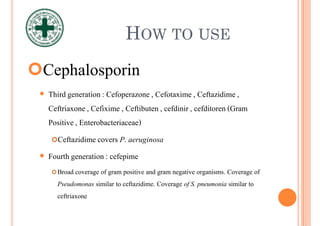аё«аёҘаёұаёҒаёҒаёІаёЈа№ғаёҠа№үаёўаёІаё•а№үаёІаёҷаёҲаёёаёҘаёҠаёөаёһ
- 2. OUTLINE пӮўWhat are antibiotics. пӮўHow do they work. пӮўHow to use. пӮўPrecaution. пӮўDUE
- 3. WHAT ARE ANTIBIOTICS пӮўаёӘаёІаёЈаё—аёөаёӘаёЈа№үаёІаёҮаёӮаё¶аёҷа№ҒаёҘаё°а№ҒаёўаёҒไดа№үаёҲаёІаёҒа№ҖаёҠаё·аёӯаёҲаёёаёҘаёҠаёөаёһаёҠаёҷаёҙаё”аё«аёҷаё¶аёҮаё«аёЈаё·аёӯаёӘаёұаёҮа№Җаё„аёЈаёІаё°аё«а№Ң аёӮаё¶аёҷаёЎаёІ аёЎаёөаёӨаё—аёҳаёҙаёўаёұаёҡаёўаёұаёҮаёҒаёІаёЈа№ҖаёҲаёЈаёҙаёҚа№Җаё•аёҙаёҡа№Ӯаё•(bacteriostatic)аё«аёЈаё·аёӯаё—а№ҚаёІаёҘаёІаёўа№ҖаёҠаё·аёӯ аёҲаёёаёҘаёҠаёөаёһ(Bacteriocidal) пӮўа№Ӯаё”аёўаёҲа№ҚаёІа№ҒаёҷаёҒаёӘаёІаёЈаёҲаёІаёҒа№Ӯаё„аёЈаёҮаёӘаёЈа№үаёІаёҮаё—аёІаёҮа№Җаё„аёЎаёөа№ҒаёҘаё°аёҒаёҘไаёҒаёҒаёІаёЈаёӯаёӯаёҒаёӨаё—аёҳаёҙ
- 4. HOW TO DO THEY WORK
- 5. HOW TO DO THEY WORK
- 6. HOW TO USE пӮўPenicillin пӮ—Beta-lactam ring пӮ—аёҲаёұаёҡаёҒаёұаёҡ PBPs inhibits transpeptidase action пӮ—Gram positive and Gram negative cocci пӮ—Amoxycliin , Ampicillin , Penicllin G , Cloxacillin etc. пӮ—Piperacillin : Pseudomonas
- 7. PRECAUTION пӮўPenicillin пӮ— аёЈаё°аё§аёұаёҮа№ғаёҷаёңаё№а№үаёӣа№Ҳаё§аёўаё—аёөаёЎаёөаёӣаёЈаё°аё§аёұаё•аёҙа№Ғаёһа№үpenicillin пӮ— Augmentin , Ampicillin аёҲаё°аё„аёҮаё•аёұаё§аё«аёҘаёұаёҮаёңаёӘаёЎаёўаёІ 8 hr пӮ— аёҒаёІаёЈаёңаёӘаёЎ Cloxacillin а№ғаёҷ D5W аёҲаё°аё—а№ҚаёІа№ғаё«а№ү pH аёӮаёӯаёҮаёӘаёІаёЈаёҘаё°аёҘаёІаёў аё„а№ҲаёӯаёҷаёӮа№үаёІаёҮไаёӣ аё—аёІаёҮаёҒаёЈаё”аёЎаёІаёҒаёҒаё§а№ҲаёІNSS аёӢаё¶аёҮаё—а№ҚаёІа№ғаё«а№үа№ӮаёӯаёҒаёІаёӘа№ҖаёҒаёҙаё” phlebitis аёӘаё№аёҮаёӮаё¶аёҷ пӮ— Augmentin а№Җаёҷаё·аёӯаёҮаёҲаёІаёҒаёЎаёө Clavulanic а№Җаёӣа№ҮаёҷаёӘа№Ҳаё§аёҷаёӣаёЈаё°аёҒаёӯаёҡаё—а№ҚаёІа№ғаё«а№ү S/E аё„аё·аёӯ аё„аёҘаё·аёҷไаёӘа№ү аёӯаёІа№ҖаёҲаёөаёўаёҷаё«аёЈаё·аёӯаё—а№үаёӯаёҮа№ҖаёӘаёөยไดа№ү пӮ— PGS аёҒаёІаёЈа№ғаё«а№үа№Ғаёҡаёҡ IV push аёҲаё°а№ҖаёһаёҙаёЎаё„аё§аёІаёЎа№ҖаёӘаёөаёўаёҮ аё•а№ҲаёӯаёҒаёІаёЈа№ҖаёҒаёҙаё”neurotoxic
- 8. HOW TO USE пӮўCephalosporin пӮ— Beta-lactam ring аё„аёҘа№үаёІаёўаёҒаёұаёҡ Penicillin пӮ— аёҲаёұаёҡаёҒаёұаёҡ PBPs inhibits transpeptidase action пӮ— 5 Generations пӮў First generation : Cefazolin , Cephalexine(Streptococci and S. aureas , E. coli, Klebsiella species, P. mirabilis) пӮўSecond generation: Cefuroxime , Cefoxitin ( First , S. pneumoniae , H. influenza,M. catarrhalis, Neisseria species)
- 9. HOW TO USE пӮўCephalosporin пӮ— Third generation: Cefoperazone , Cefotaxime , Ceftazidime , Ceftriaxone, Cefixime , Ceftibuten, cefdinir, cefditoren (Gram Positive, Enterobacteriaceae) пӮўCeftazidimecovers P. aeruginosa пӮ— Fourth generation: cefepime пӮўBroad coverage of gram positive and gram negative organisms. Coverage of Pseudomonas similar to ceftazidime. Coverage of S. pneumonia similar to ceftriaxone
- 10. HOW TO USE пӮўCephalosporin пӮ— Fifth generation : Ceftaroline пӮўEnhancedcoverage of gram positiveorganisms: MRSA, S. pneumonia,and E. faecalis пӮўSimilargram negativecoverage to third- and fourth-generation agents.Does not cover Pseudomonas.
- 11. PRECAUTION пӮўCephalosporin пӮ— аёЈаё°аё§аёұаёҮа№ғаёҷаёңаё№а№үаёӣа№Ҳаё§аёўаё—аёөаёЎаёөаёӣаёЈаё°аё§аёұаё•аёҙа№Ғаёһа№үpenicillin пӮ— Cefoperzone аё„аё§аёЈаёЈаё°аёЎаёұаё”аёЈаё°аё§аёұаёҮаёҒаёІаёЈа№ғаёҠа№үа№ғаёҷаёңаё№а№үаёӣа№Ҳаё§аёўа№ӮаёЈаё„аё•аёұаёҡ пӮ— Ceftriaxone аё«а№үаёІаёЎаё—а№ҚаёІаёҘаё°аёҘаёІаёўаё«аёЈаё·аёӯаёңаёӘаёЎаёўаёІ аё”а№үаё§аёў calcium-containing products а№ҖаёҠа№Ҳаёҷ RingerвҖҷs solution аё«аёЈаё·аёӯ parenteral nutrition аё—аёөаёЎаёө calcium а№Җаёӣа№ҮаёҷаёӘа№Ҳаё§аёҷаёңаёӘаёЎ а№Җаёҷаё·аёӯаёҮаёҲаёІаёҒаёӯаёІаёҲа№ҖаёҒаёҙаё”аёҒаёІаёЈаё•аёҒаё•аё°аёҒаёӯаёҷ
- 12. HOW TO USE пӮўCarbapenem пӮ— Gram negativeand positive пӮ— Beta-lactam ring аёЎаёөаё„аё§аёІаёЎаё„аёҮаё•аёұаё§аё•а№Ҳаёӯ ESBLs пӮ— аёҲаёұаёҡаёҒаёұаёҡ PBPs inhibits transpeptidase action пӮўImipenem : ไวตа№ҲаёӯаёҒаёІаёЈаё–аё№аёҒаё—а№ҚаёІаёҘаёІаёўаё”а№үаё§аёў dehydropeptidase(DHP-I) пӮўErtapenem : ไมа№ҲаёЎаёөаёӨаё—аёҳаёҙаё•а№Ҳаёӯа№ҖаёҠаё·аёӯ Pseudomonas пӮўDoripenem пӮўMeropenem
- 13. PRECAUTION пӮўCarbapenem пӮўаёӯаёІаёҒаёІаёЈаёӮа№үаёІаёҮа№Җаё„аёөаёўаёҮаё—аёөаёһаёҡไดа№үаёҡа№Ҳаёӯаёўаё„аё·аёӯ аё„аёҘаё·аёҷไаёӘа№ү аёӯаёІа№ҖаёҲаёөаёўаёҷ пӮўаёЈаё°аё§аёұаёҮа№ғаёҷаёңаё№а№үаёӣа№Ҳаё§аёўа№Ғаёһа№үpenicillin пӮўаёЈаё°аё§аёұаёҮаёҒаёІаёЈа№ғаёҠа№үаёўаёІа№ғаёҷаёңаё№а№үаёӣа№Ҳаё§аёўаё—аёөаёӣаёЈаё°аё§аёұаё•аёҙаёҒаёІаёЈаёҠаёұаёҒ аё«аёЈаё·аёӯаёЎаёөаёӣаёұаёҚаё«аёІаё—аёІаёҮаёЈаё°аёҡаёҡ аёӣаёЈаё°аёӘаёІаё— а№Ӯаё”аёўаёўаёІаё—аёөаёҒа№Ҳаёӯа№ғаё«а№үа№ҖаёҒаёҙаё”аёЎаёІаёҒаёӘаёёаё”аё„аё·аёӯImipenem пӮўаёЈаё°аё§аёұаёҮаёҒаёІаёЈа№ғаёҠа№үаёўаёІа№ғаёҷаёңаё№а№үаёӣа№Ҳаё§аёўаё—аёөа№ғаёҠа№үаёўаёІ Valproic acid аёЈа№Ҳаё§аёЎаё”а№үаё§аёўа№Җаёҷаё·аёӯаёҮаёҲаёІаёҒаёўаёІ а№ғаёҷаёҒаёҘаёёа№ҲаёЎ Carbapenem аёҲаё°аё—а№ҚаёІа№ғаё«а№үаёЈаё°аё”аёұаёҡаёўаёІ Valproic аёҘаё”аёҘаёҮ пӮўImipenem ไมа№Ҳаё„аё§аёЈаёңаёӘаёЎаёҒаёұаёҡаёӘаёІаёЈаёҘаё°аёҘаёІаёўаё—аёөаёЎаёө lactate пӮўMeropenem аё«аёҘаёұаёҮаёңаёӘаёЎаё”а№үаё§аёў NSS аёҲаё°аё„аёҮаё•аёұаё§ 8 hr at room temp
- 14. HOW TO USE пӮўVancomycin пӮ— Gram positive, MRSA пӮ— аёҲаёұаёҡаёҒаёұаёҡ D-Ala-D-Ala а№ҒаёҘаё° inhibit transglycosylase пӮ— аё•а№үаёӯаёҮаёЎаёөаёҒаёІаёЈаё•аёЈаё§аёҲаё•аёҙаё”аё•аёІаёЎаё§аёұаё”аёЈаё°аё”аёұаёҡаёўаёІ пӮўа№Ғаёҡа№ҲаёҮа№ҖаёҲаёІаё°а№Җаёӣа№Үаёҷа№Ғаёҡаёҡ Peak аёҒаёұаёҡ Though пӮўPeak аёҲаё°а№ҖаёҲаёІаё°аё§аёұаё”аё«аёҘаёұаёҮไดа№үаёўаёІ 30 аёҷаёІаё—аёөаё«аёҘаёұаёҮа№ғаё«а№үаёўаёІаё„аёЈаёҡ 1 hr аёЈаё°аё”аёұаёҡаё—аёөаё„аё§аёЈаё§аёұดไดа№ү аё„аё·аёӯ 30-40 mcg/ml пӮўThrough аёҲаё°а№ҖаёҲаёІаё°аёҒа№Ҳаёӯаёҷа№ғаё«а№үаёўаёІ dose аё–аёұดไаёӣ 30 аёҷаёІаё—аёө аёЈаё°аё”аёұаёҡаёўаёІаё—аёөаё„аё§аёЈаё§аёұดไดа№үаё„аё§аёЈ аёӯаёўаё№а№Ҳаё—аёө 15-20 mcg/ml
- 15. PRECAUTION пӮўVancomycin пӮўа№ҖаёҲаё·аёӯаёҲаёІаёҮаёўаёІа№ғаёҷаёӘаёІаёЈаёҘаё°аёҘаёІаёў NSS аё«аёЈаё·аёӯ D5W пӮўmax conc = 5 mg/mL пӮўаё„аё§аёЈаёҡаёЈаёҙаё«аёІаёЈаёўаёІа№Ӯаё”аёў IV infusion аёӣаёЈаё°аёЎаёІаё“ 2 аёҠаёұаё§а№ӮаёЎаёҮ аёӘа№ҚаёІаё«аёЈаёұаёҡаёўаёІ 1 g пӮўmax rate = 10 mg/min пӮўаёЈаё°аё§аёұаёҮаёҒаёІаёЈа№ҖаёҒаёҙаё” Redman Syndrome пӮ— аёӯаёІаёҒаёІаёЈа№ғаёҲаёӘаёұаёҷ аё«аёІаёўа№ғаёҲаёҘа№ҚаёІаёҡаёІаёҒ аёӯаёІаёҲаёЎаёө hypotension пӮ— аёһаёҡаёңаё·аёҷа№Ғаёҡаёҡ MP rash аёҡаёЈаёҙа№Җаё§аё“аё«аёҷа№үаёІаёӯаёҒ аё„аёӯ аё«аёҘаёұаёҮ а№ҒаёӮаёҷ пӮ— аёӯаёІаёҒаёІаёЈаёЎаёұаёҒа№ҖаёҒаёҙаё”аёӮаё¶аёҷаё«аёҘаёұаёҮ infuse ยาไаёӣаёӣаёЈаё°аёЎаёІаё“ 15-45 аёҷаёІаё—аёө пӮ— аёӯаёІаёҒаёІаёЈаёЎаёұаёҒหายไаёӣаё«аёҘаёұаёҮหยุดยาไаёӣ 10-60 аёҷаёІаё—аёө пӮ— а№ҖаёҠаё·аёӯаё§а№ҲаёІа№ҖаёҒаёҙаё”аёҲаёІаёҒаёҒаёІаёЈаё«аёҘаёұаёҮhistamine аёҲаёІаёҒ mast cell
- 16. HOW TO USE пӮўFosfomycin пӮ— Gram positive, MRSA пӮ— аёўаёұаёҡаёўаёұаёҮа№ҖаёӯаёҷไаёӢаёЎа№ҢMurA аёӢаё¶аёҮа№Җаёӣа№ҮаёҷаёӘаёІаёЈаёӘа№ҚаёІаё„аёұаёҚа№ғаёҷаёҒаёІаёЈаёӘаёЈа№үаёІаёҮ Peptidoglycan аёӘа№ҲаёҮаёңаёҘаёўаёұаёҡаёўаёұаёҮаёҒаёІаёЈаёӘаёЈа№үаёІаёҮаёңаёҷаёұаёҮа№ҖаёӢаёҘаёҘа№ҢаёӮаёӯаёҮа№ҖаёҠаё·аёӯа№Ғаёҡаё„аё—аёөа№ҖаёЈаёөаёў
- 17. PRECAUTION пӮўFosfomycin пӮўаёЈаё°аё§аёұаёҮа№ғаёҷаёңаё№а№үаёӣа№Ҳаё§аёўаё—аёөаёҲа№ҚаёІа№Җаёӣа№Үаёҷаё•а№үаёӯаёҮаёҲа№ҚаёІаёҒаёұаё”а№ҖаёҒаёҘаё·аёӯа№ӮаёӢа№Җаё”аёөаёўаёЎа№Җаёҷаё·аёӯаёҮаёҲаёІаёҒаё аёІаё§аё° Cardiac failure аё«аёЈаё·аёӯ renal failure , hypertension аё«аёЈаё·аёӯаё аёІаё§аё°аёӯаё·аёҷ
- 18. HOW TO USE пӮўColistin пӮ— аёӯаёӯаёҒаёӨаё—аёҳаёҙаё—а№ҚаёІаёҘаёІаёўаёңаёҷаёұаёҮа№ҖаёӢаёҘаёҘа№ҢаёҠаёұаёҷаёҷаёӯаёҒаёӮаёӯаёҮа№Ғаёҡаё„аё—аёөа№ҖаёЈаёөаёў а№Ӯаё”аёўаёҒаёІаёЈа№ғаёҠа№ү Electrostatic interactions аёЈаё°аё«аё§а№ҲаёІаёҮаё•аёұаё§аёўаёІаё—аёөа№Җаёӣа№Үаёҷcation аёҒаёұаёҡ lipopolysaccharide аёӮаёӯаёҮаёңаёҷаёұаёҮа№ҖаёӢаёҘаёҘа№ҢаёҠаёұаёҷаёҷаёӯаёҒаё—аёөа№Җаёӣа№Үаёҷ anion а№ҖаёҒаёҙаё”аёҒаёІаёЈаёЈаёұวไหаёҘ аёӮаёӯаёҮаёӘаёІаёЈа№ғаёҷа№ҖаёӢаёҘаёҘа№Ңа№ҒаёҘаё°аё—а№ҚаёІа№ғаё«а№үа№ҖаёӢаёҘаёҘа№Ңаё•аёІаёўа№ғаёҷаё—аёөаёӘаёёаё” пӮ— Preserved for infectionfrom MDR or pan-DR A. baumannii,P. aeruginosa,or enterobacteriaceaes
- 19. PRECAUTION пӮўColistin пӮўContraindication: polymyxinallergy пӮўаёЎаёөаё—аёұаёҮ IV а№ҒаёҘаё° NB пӮўаёӣаёЈаёұаёҡаёӮаёҷаёІаё”аёўаёІаё•аёІаёЎаёҒаёІаёЈаё—а№ҚаёІаёҮаёІаёҷаёӮаёӯаёҮไต пӮўReconstitutewith 2 ml SWI to obtaina 75 mg/ml пӮўInjectionover 3-5 min пӮўDo not exceed 5 mg/kg/daywith normal renal function
- 20. HOW TO USE пӮўFluoroquinolone пӮ— Block bacterial DNA synthesis by inhibiting bacterialtopoisomerase II (DNA gyrase) and topoisomeraseIV пӮ— gram-negativebacilli,gram-negativecocci nonenteric gram-negative bacillisuch as Pseudomonasaeruginosa and staphylococci пӮ— Levofloxacinand Moxifloxacinless active against Pseudomonas aeruginosathan ciprofloxacin.
- 21. PRECAUTION пӮўFluoroquinolone пӮ— Ciprofloxacin : 1-2 mg/mL into large vein over 60 min пӮ— Levofloxacin :250-500 mg over 60 min and 750 mg over 90 min пӮ— Avoidedduring pregnancy and lactation пӮ— Most common side effect are nausea , peripheral neuropathy, dizziness. пӮ— QT prolongation пӮ— Interactionwith warfarin
- 22. HOW TO USE пӮўMacrolide пӮ— аёўаёұаёҡаёўаёұаёҮаёҒаёІаёЈаёӘаёұаёҮа№Җаё„аёЈаёІаё°аё«а№Ңа№ӮаёӣаёЈаё•аёөаёҷаёӮаёӯаёҮа№Ғаёҡаё„аё—аёөа№ҖаёЈаёөаёў аёңа№ҲаёІаёҷаёҒаёҘไаёҒаёҒаёІаёЈаёӯаёӯаёҒаёӨаё—аёҳаёҙаё„аё·аёӯ а№Ғаё—аёЈаёҒ аёӢаё¶аёЎаёңа№ҲаёІаёҷаёңаёҷаёұаёҮа№ҖаёӢаёҘаёҘа№ҢаёӮаёӯаёҮа№Ғаёҡаё„аё—аёөа№ҖаёЈаёөаёўа№ҒаёҘаё°аёҲаёұаёҡаёҒаёұаёҡ 50S ribosome subunit аёҲаё¶аёҮаёўаёұаёҡаёўаёұаёҮ аёҒаёІаёЈ а№Җаё„аёҘаё·аёӯаёҷаёўа№үаёІаёў (translocation) аёӮаёӯаёҮ aminoacyl transfer-RNA аё—аёөаёЎаёөаёңаёҘаё•аёӯаёҒаёІаёЈ аёӘаёұаёҮа№Җаё„аёЈаёІаё°аё«а№Ңа№ӮаёӣаёЈаё•аёөаёҷ пӮ— Gram positive : Streptococcus pyogenes S. pneumoniae ,Staphylococcus aureus Listeria, monocytogenes а№ҒаёҘаё° enterococci пӮ— Gram negative : Neisseria gonorrhoeae ,N. meningitidis Moraxella catarrhalis ,Legionella pneumophila а№ҒаёҘаё° H. influenzae macrolides пӮ— Mycoplasma pneumoniae ,Chlamydia trachomatis Mycobacterium avium complex а№ҒаёҘаё° Helicobacter pyroli
- 23. PRECAUTION пӮўMacrolide пӮ— Azithomycin: 1 mg/mL infuse over 3 hr 2 mg/mL infuse over 1 hr пӮ— QT interval prolongation пӮ— Most common side effect : nausea , vomit , diarrhea , abdominalpain
- 24. HOW TO USE пӮўAminoglycoside пӮ— Bindingto the aminoacyl site of 16S ribosomal RNA within the 30S ribosomalsubunit пӮ— Gram positiveand negativeand Mycobacteria
- 25. PRECAUTION пӮўAminoglycoside пӮ— Nephrotoxicity , ototoxicity пӮ— Gentamicin : NSS аё«аёЈаё·аёӯ D5W пӮў Maximum concentration : 1 mg/mL пӮў Infuse over 30 min вҖ“ 2hr пӮ— Amikacin : NSS, D5W, D5N, LRS пӮў Maxconc. 10 mg/mL пӮў а№ғаёҷа№Җаё”а№ҮаёҒ а№ғаё«а№ү IV drip аёҷаёІаёҷ 1-2 аёҠаёұ'аё§а№ӮаёЎаёҮ пӮў аё«а№үаёІаёЎаёҡаёЈаёҙаё«аёІаёЈа№Ӯаё”аёў IV push пӮ— Streptomycin : Intramuscular only пӮў аёҘаё°аёҘаёІаёўаёңаёҮаёўаёІ 1 g with SWI 1.4 mL аёҲะไดа№үаёӘаёІаёЈаёҘаё°аёҘаёІаёў 2 mL а№ҖаёЎаё·аёӯаёңаёӘаёЎаёўаёІа№ҒаёҘа№үаё§аё•аёұаёҮаё—аёҙаёҮไวа№үаёӘаёІаёЈаёҘаё°аёҘаёІаёў аёӯаёІаёҲаёЎаёөаёҒаёІаёЈ а№ҖаёӣаёҘаёөаёўаёҷаёӘаёөไดа№үа№ҖаёҠа№Ҳаёҷ а№ҖаёӣаёҘаёөаёўаёҷа№Җаёӣа№ҮаёҷаёӘаёөа№Җаё«аёҘаё·аёӯаёҮаёӯа№Ҳаёӯаёҷаё«аёЈаё·аёӯаёӘаёөаёҠаёЎаёһаё№аёҲаёІаёҮа№Ҷ а№ҒаёҘаё°аёҲаё°аёЎаёөаёӘаёөа№ҖаёӮа№үаёЎаёӮаё¶аёҷа№ҖаёЎаё·аёӯаё•аёұаёҮаё—аёҙаёҮ ไวа№үаёҷаёІаёҷаёЎаёІаёҒаёӮаё¶аёҷ а№Ғаё•а№ҲаёўаёұаёҮаёӘаёІаёЎаёІаёЈаё–а№ғаёҠа№үаёўаёІ
- 26. HOW TO USE oTigecycline пӮ— First drug in the glycylcyclineclass пӮ— pneumoniae,MRSA,MRSE,VRE пӮ— Bindsto the bacterial 30S ribosome, blockingthe entry of transfer RNA
- 27. PRECAUTION oTigecycline пӮ— Patienthas severe hepaticimpairment (Child-Pughclass C), a dose of 25 mg every 12 hours should be given after a loadingdose of 100 mg. пӮ— Doses are given intravenouslyover 30 to 60 minutes. пӮ— TYGACIL is not indicated for the treatment of hospital-acquiredor ventilator-associatedpneumonia
- 28. DUE




























